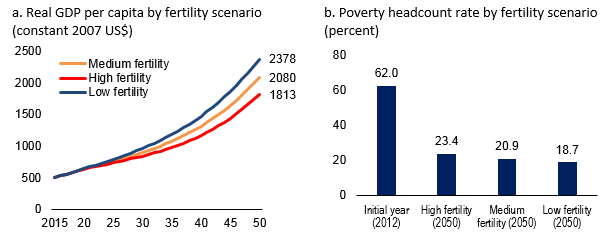Family Planning, Demographic Change and Poverty: A Call for Action
This blog originally appeared on the Investing in Health Blog on January 27, 2016
More than 3,500 people, including Presidents and Prime Ministers, have gathered in Bali this week for the fourth International Conference on Family Planning. The unmet need for family planning is an urgent human right and development issue. We’ve no more time to lose!
In 2013, approximately 289,000 women died from problems related to pregnancy or childbirth. The Bill & Melinda Gates Foundation, however, estimates that approximately 1 in 4 women could be saved if they had global access to contraception. Simply meeting the unmet need for family planning services would also prevent 1.1 million infant deaths. Family planning remains out of reach for many couples in low-income settings—more than 200 million couples in the developing world are unable to control the number and spacing of their births.
In many African countries, the level of unmet need for family planning exceeds the level of contraceptive use. Family planning is one of the most cost-effective interventions to improve the human condition, with enduring health and welfare benefits for women, families, and nations. Future decades will see a record number of young people entering prime reproductive age, requiring effective means to prevent unplanned pregnancy and achieve healthy timing and spacing of pregnancies.
A recent report by the World Bank indicates that access to comprehensive family planning services is not only necessary to improve the lives of women, children and families, but is also one of the policies needed to accelerate the demographic transition in countries that have had persistently high levels of fertility. This acceleration would result in a more favorable population age structure, where larger shares of people are of working age, and with the right policies in place, could result in much needed accelerated economic growth and poverty reduction.
One country in urgent need of increased access to family planning is Mozambique. In 2011 only 11% of married women were using any modern contraceptive method. The total fertility rate increased from 5.2 in 1997 to 5.5 in 2003, and to 5.9 in 2011 for the country as a whole – in 2011 it was 6.6 in rural areas. Due to high fertility, the country’s projected population growth is very high, and the proportion of working age population is very low. This is not helping economic growth. A faster transition to lower fertility rates would result in more rapid economic growth and poverty reduction.
Figure: A one child difference in fertility rates by 2050 can lead to differences of 31 percent in real GDP per capita and of 5 percentage points in poverty headcount rates in Mozambique

Source: Simulation results from LINKAGE and GIDD.
Note: The scenarios consider the age-structure changes projected in the medium, high, and low fertility scenarios of United Nations (2015). The poverty headcount rate is based on the $1.90 international poverty line with the 2011 PPP weights. 2012 is the benchmark year of the World Bank Group’s most recent official global poverty estimates.
The World Bank contributes to alleviating the unmet need for family planning by helping women realize their preferred reproductive health preferences in order to increase families’ wellbeing, and accelerate economic growth and poverty reduction.
Our Sahel Women Empowerment and Demographic Dividend Project (SWEDD) aims to increase demand for family planning and improve gender equality to reduce fertility and improve women’s bargaining and economic potential. SWEDD addresses both supply-side issues related to family planning services (i.e. commodities and health workers), while focusing on women’s and girls’ empowerment.
The project finances a regional call for proposals on girls’ education, life skills training and economic empowerment. This approach maximizes peer evaluation and knowledge exchange between the six SWEDD countries. It is a true multi-sector and regional effort (involving health, gender, education and social protection teams), the first at the Bank on this topic. The World Bank’s Board recently approved a complementary population and health project for Niger (the country with the highest total fertility rate in the world, 7.6 children per woman) for $105 million.
The World Bank also expects to see future financial commitments to improve access to family planning services thanks to the Global Financing Facility (GFF) in support of Every Woman Every Child (GFF). The GFF is a key financing platform of the UN Secretary General’s updated Global Strategy for Women’s, Children’s and Adolescents’ Health (2016-2030). It is a country-driven financing partnership that brings together, under national leadership and ownership, stakeholders in reproductive, maternal, newborn, child and adolescent health (RMNCAH), to accelerate efforts to end preventable maternal, newborn, child and adolescent deaths by 2030 and improve the health and well-being of women and children.
The GFF builds on the International Health Partnership (IHP+) approach and harmonizes fragmented RMNCAH approaches, using existing structures and processes. A multi-donor trust fund—the GFF Trust Fund—was also established at the World Bank with an initial US$875 million in commitments from the Bill and Melinda Gates Foundation and the governments of Canada and Norway. The GFF Trust Fund provides additional financing for RMNCAH and links grant funding to IDA or IBRD projects.
The World Bank’s global practice for health, nutrition and population is committed to helping countries accelerate progress towards achieving universal health coverage, including family planning and other reproductive health services. The challenge is huge, but progress is happening and is making a difference for many women, children and families.